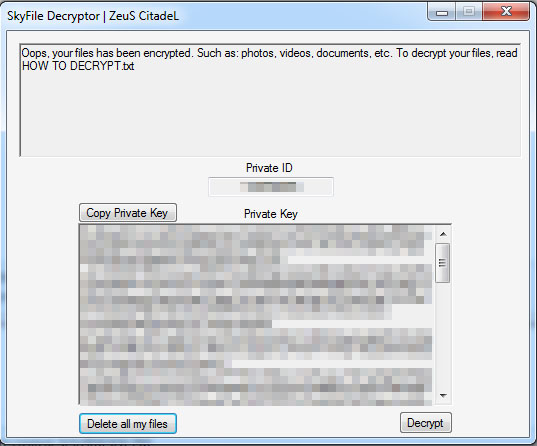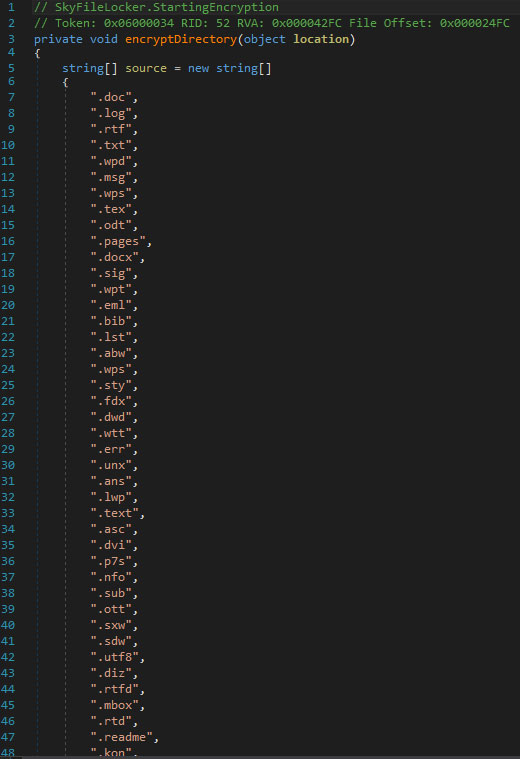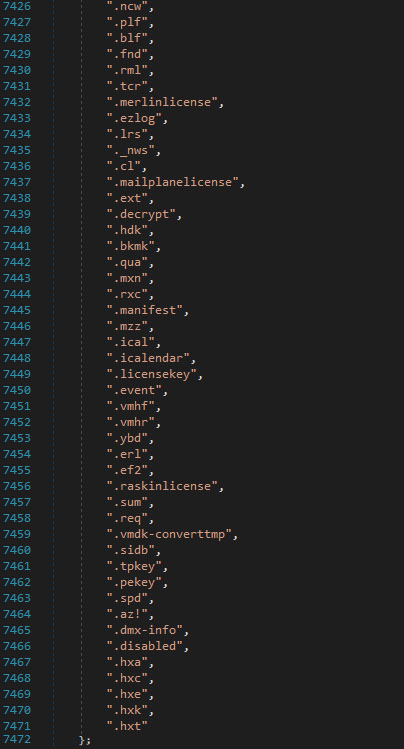RANSOM_SKYFILE.THDAFAH
HEUR:Trojan.Win32.Generic (Kaspersky), Trojan.Gen.2 (Norton), Gen:Heur.Ransom.Imps.3 (BitDefender)
Windows


Threat Type: Ransomware
Destructiveness: No
Encrypted:
In the wild: Yes
OVERVIEW
This Ransomware arrives on a system as a file dropped by other malware or as a file downloaded unknowingly by users when visiting malicious sites.
TECHNICAL DETAILS
Arrival Details
This Ransomware arrives on a system as a file dropped by other malware or as a file downloaded unknowingly by users when visiting malicious sites.
Installation
This Ransomware drops the following files:
- {Encrypted Directory}\SkyFile Decryptor.lnk
- {Encrypted Directory}\HOW TO DECRYPT.txt
- %System%\SkyFile Decryptor.exe
- %AppDataLocal%\{Random Strings}
- %Windows%\debuglog.dll
(Note: %System% is the Windows system folder, where it usually is C:\Windows\System32 on all Windows operating system versions.. %AppDataLocal% is the Application Data folder found in Local Settings, where it is usually C:\Documents and Settings\{user name}\Local Settings\Application Data on Windows 2000, Windows Server 2003, and Windows XP (32- and 64-bit); C:\Users\{user name}\AppData\Local on Windows Vista (32- and 64-bit), Windows 7 (32- and 64-bit), Windows 8 (32- and 64-bit), Windows 8.1 (32- and 64-bit), Windows Server 2008, and Windows Server 2012.. %Windows% is the Windows folder, where it usually is C:\Windows on all Windows operating system versions.)
It adds the following processes:
- cmd.exe /c vssadmin.exe delete shadows /all /quiet
- cmd.exe /c wmic.exe shadowcopy delete
- cmd.exe /c bcdedit.exe /set {default} bootstatuspolicy ignoreallfailures
- cmd.exe /c wbadmin.exe delete catalog -quiet
- cmd.exe /c icacls.exe "{A-Z}:" /grant {Username}:F /T /C /Q <-- Creates this process to grant permission or full control for the malware to modify files in the current available directories on the infected system
It leaves text files that serve as ransom notes containing the following:
Autostart Technique
This Ransomware adds the following registry entries to enable its automatic execution at every system startup:
HKEY_CURRENT_USER\Software\Microsoft\
Windows\CurrentVersion\Run
Java Platform Auto Updater = {Current Malware Directory}\{Malware Name}.exe
Information Theft
This Ransomware gathers the following data:
- Username
- Computer Name
- Network Address
- IP Address
- Operating System
- OS Version Info
Other Details
This Ransomware does the following:
- It drops the following decryptor to all successfully encrypted drives
- It is capable of encrypting a total of 7,465 extensions.
- It encrypts all files in fixed and network drives.
Ransomware Routine
This Ransomware renames encrypted files using the following names:
- {Random Characters}.{Random 3 Characters}.sky
It appends the following extension to the file name of the encrypted files:
- .sky
SOLUTION
Step 1
Before doing any scans, Windows XP, Windows Vista, and Windows 7 users must disable System Restore to allow full scanning of their computers.
Step 2
Note that not all files, folders, and registry keys and entries are installed on your computer during this malware's/spyware's/grayware's execution. This may be due to incomplete installation or other operating system conditions. If you do not find the same files/folders/registry information, please proceed to the next step.
Step 3
Restart in Safe Mode
Step 4
Delete this registry value
Important: Editing the Windows Registry incorrectly can lead to irreversible system malfunction. Please do this step only if you know how or you can ask assistance from your system administrator. Else, check this Microsoft article first before modifying your computer's registry.
- In HKEY_CURRENT_USER\Software\Microsoft\Windows\CurrentVersion\Run
- Java Platform Auto Updater = {Current Malware Directory}\{Malware Name}.exe
- Java Platform Auto Updater = {Current Malware Directory}\{Malware Name}.exe
Step 5
Search and delete this file
- {Encrypted Directory}\SkyFile Decryptor.lnk
- {Encrypted Directory}\HOW TO DECRYPT.txt
- %System%\SkyFile Decryptor.exe
- %AppDataLocal%\{Random Strings}
- %Windows%\debuglog.dll
Step 6
Restore encrypted files from backup.
Step 7
Restart in normal mode and scan your computer with your Trend Micro product for files detected as RANSOM_SKYFILE.THDAFAH. If the detected files have already been cleaned, deleted, or quarantined by your Trend Micro product, no further step is required. You may opt to simply delete the quarantined files. Please check this Knowledge Base page for more information.
NOTES:
Enabling Volume Shadow Service
1. Run the command prompt (cmd.exe) as administrator.
2. Enable Volume Shadow Service by typing the following command: net start vss
Enabling Windows Error Recovery
1. Run the command prompt (cmd.exe) as administrator.
2. Enable Windows Error Recovery Screen on Startup use the following command: bcdedit /set {default} bootstatuspolicy displayallfailures
Enabling Startup Repair
1. Run the command prompt (cmd.exe) as administrator.
2. Enable Startup Repair use the following command: /bcedit /set {default} recoveryenabled Yes
Did this description help? Tell us how we did.






